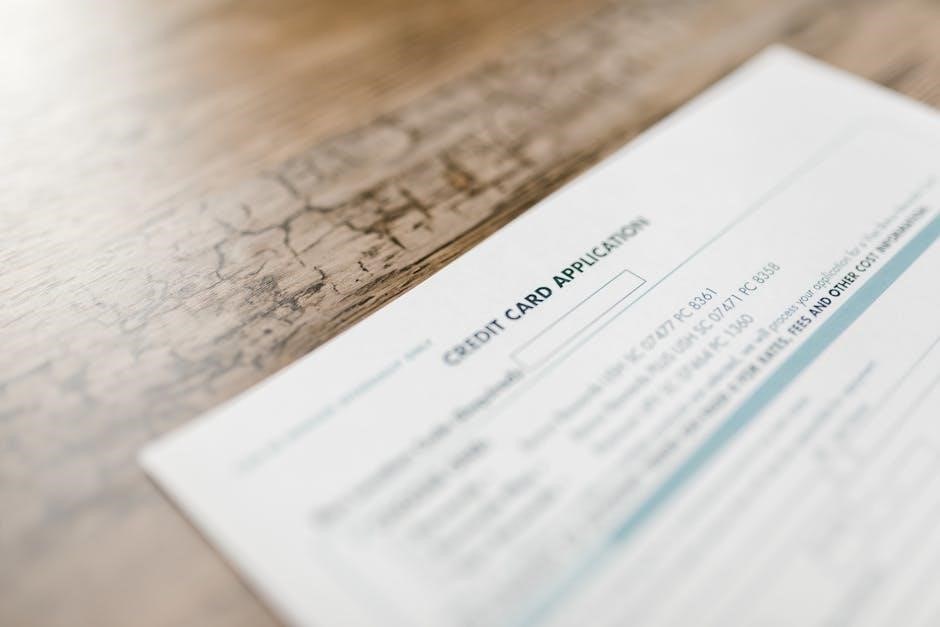The Ontario Rental Application Form 410 is a standardized document developed by the Ontario Real Estate Association (OREA) to streamline the rental application process. It collects essential personal, rental history, and employment information, helping landlords evaluate potential tenants efficiently while ensuring compliance with provincial regulations. This form is widely recognized and utilized across Ontario, making it a crucial tool for both landlords and renters.
1.1 Overview of the Form and Its Importance
The Ontario Rental Application Form 410 is a standardized document designed to streamline the rental process. It collects essential information about applicants, ensuring landlords can evaluate tenants fairly and consistently. This form is vital for maintaining professionalism and legal compliance in Ontario’s rental market, providing a clear and transparent framework for both landlords and tenants.
1.2 Purpose of the Ontario Rental Application Form 410
The primary purpose of Form 410 is to provide landlords with a comprehensive tool to assess potential tenants. It facilitates the collection of personal, rental, and employment information, helping landlords make informed decisions while ensuring compliance with Ontario’s rental regulations. This form also protects tenants by standardizing the application process and promoting fair screening practices.

About the Ontario Rental Application Form 410
The Ontario Rental Application Form 410 is a standardized document created by OREA for rental applications in Ontario. It aids landlords in evaluating tenants and ensures compliance with rental regulations, streamlining the application process.
2.1 Structure and Content of the Form
The Ontario Rental Application Form 410 is a two-page document divided into clear sections, including personal information, rental history, employment details, and a consent section. It features fillable fields for applicant details, ensuring a structured and organized approach to collecting necessary information. The form is designed to be comprehensive, making it easier for landlords to evaluate potential tenants efficiently.
2.2 Key Sections of the Form
The Form 410 includes sections for applicant identification, rental history, employment details, and financial information. Applicants must provide personal details, previous landlords’ contacts, and employment verification. A consent section allows landlords to conduct background checks, ensuring a thorough tenant screening process while maintaining compliance with Ontario’s rental regulations and standards.
2.3 Legal Requirements and Compliance
The Ontario Rental Application Form 410 complies with provincial rental laws, ensuring a fair and transparent tenant screening process. It adheres to the Residential Tenancies Act and other regulations, protecting both landlords and tenants. The form’s standardized format helps avoid discrimination and ensures all necessary legal requirements are met during the rental application process in Ontario.
How to Fill Out the Ontario Rental Application Form 410
The form requires detailed personal information, rental history, employment details, and a signature. Applicants must provide accurate and complete data to ensure proper processing and avoid delays.
3.1 Personal Information Required
The form requires applicants to provide their full name, date of birth, contact details, and current address. Additional fields may include emergency contacts and driver’s license information for identity verification purposes.
3.2 Rental History and Employment Details
The form requires applicants to list their rental history, including previous landlords’ contact information and monthly rent amounts. Employment details, such as job title, employer, and income, are also requested to assess financial stability and reliability as a tenant.
3.4 Signature and Consent
The form requires applicants to sign and date, confirming the accuracy of the information provided. This section also includes consent for the landlord to use personal data for tenant screening, ensuring compliance with privacy laws and establishing mutual agreement on the application process.
Eligibility Criteria for Tenants
Tenants must meet specific criteria, including stable income, positive rental history, and acceptable credit scores, to qualify for rental opportunities in Ontario.
4.1 Income and Employment Verification
Applicants must provide proof of stable income and employment to demonstrate financial capability. The form requires details about current job positions, employers, and income amounts. Landlords use this information to assess the applicant’s ability to pay rent consistently, ensuring financial stability and reliability as a tenant.
4.2 Credit Score and Financial Stability
A good credit score is essential for demonstrating financial stability. Landlords use this information to assess an applicant’s reliability in paying rent. A higher score indicates better financial health, while past issues may raise concerns. Applicants with stable income and a strong credit history are often prioritized to ensure timely payments and long-term tenancy stability.
4.3 Rental History and References
Rental history and references are crucial for landlords to assess an applicant’s reliability. A positive rental history demonstrates responsible tenancy, while negative experiences may raise concerns. Applicants are typically asked to provide previous landlords’ contact information for verification. Strong references from past landlords or property managers can significantly enhance an applicant’s chances of approval, showcasing their credibility and trustworthiness as tenants.

The Role of OREA in the Rental Application Process
The Ontario Real Estate Association (OREA) developed Form 410 to standardize rental applications, ensuring a comprehensive and fair tenant screening process for landlords.
5.1 What is OREA?
The Ontario Real Estate Association (OREA) is a professional organization representing real estate practitioners in Ontario. Established to promote high standards and ethical practices, OREA provides resources like Form 410 to facilitate efficient and standardized rental applications, benefiting both landlords and tenants.
5.2 OREA’s Role in Developing the Form 410
OREA developed Form 410 to provide a standardized template for rental applications, ensuring consistency and compliance with Ontario’s legal requirements. It collects necessary information for tenant screening while protecting personal data, reflecting OREA’s commitment to supporting both landlords and tenants in the rental process efficiently and fairly.
5.3 Benefits of Using the OREA Rental Application
Using the OREA Rental Application Form 410 offers a streamlined process for landlords and tenants. It ensures compliance with legal standards, reduces disputes, and provides a clear framework for evaluating applicants. The form’s standardized format saves time, minimizes errors, and protects personal information, making it a reliable and efficient tool for rental applications in Ontario.

Submitting the Ontario Rental Application Form 410
The completed Form 410 is submitted to landlords, either in print or electronically, along with required documents like ID or proof of employment, to initiate the rental process.
6.1 How to Submit the Form to Landlords
The completed Form 410 can be submitted to landlords either in print or digitally. Applicants should include supporting documents, such as photo ID, proof of employment, and rental history, to facilitate a thorough review. Ensure the form is signed and dated, adhering to legal standards. Using the official OREA version guarantees accuracy and fairness in the tenant screening process.
6.2 Processing Time and Follow-Up
Processing times for Form 410 vary, typically ranging from a few days to a week. Applicants should follow up with landlords to confirm receipt and inquire about the status. Professional communication and patience are key during this period. Ensuring all information is complete and accurate can expedite the review process and improve chances of approval.

Tenants’ Rights and Responsibilities
Tenants have the right to privacy and protection of their personal information. They must provide accurate details and consent to its use for screening purposes only.
7.1 Understanding the Legal Implications
The Ontario Rental Application Form 410 is governed by provincial laws, ensuring tenants’ rights to privacy and fair treatment. Landlords must use the form solely for screening purposes, adhering to the Residential Tenancies Act (RTA) and avoiding discrimination. Tenants are protected under these regulations, maintaining their legal rights throughout the rental application process.
7.2 Protecting Personal Information
The Ontario Rental Application Form 410 includes clauses ensuring the protection of applicants’ personal information. Landlords are legally obligated to use the data solely for tenant screening and must comply with privacy laws. The form restricts the sharing or misuse of sensitive details, safeguarding applicants’ privacy while ensuring landlords can assess suitability responsibly and securely.

Landlords’ Responsibilities and Screening Criteria
Landlords in Ontario must adhere to fair housing practices and legal standards when screening tenants using Form 410. They assess applicants based on income, rental history, and creditworthiness to ensure responsible tenant selection and compliance with provincial regulations.
8.1 Fair Screening Practices
Landlords must avoid discrimination based on race, gender, marital status, or other protected grounds under Ontario’s Human Rights Code. They should evaluate tenants consistently, focusing on relevant factors like income, credit history, and rental references, ensuring a fair and non-discriminatory screening process when using Form 410.
8.2 Discrimination and Legal Compliance
Landlords must comply with Ontario’s Human Rights Code, avoiding discrimination based on race, gender, marital status, disability, or other protected grounds. They cannot ask inappropriate questions or make decisions based on prohibited factors. Legal compliance requires fair practices, ensuring tenant screening aligns with the Residential Tenancies Act and does not infringe on applicants’ rights.

Benefits of Using the Ontario Rental Application Form 410
The form standardizes the rental application process, ensuring efficiency and fairness for both landlords and tenants. It provides a comprehensive framework for tenant screening and legal compliance.
9.1 Streamlined Application Process
The Ontario Rental Application Form 410 simplifies the rental process by organizing applicant information into clear, structured sections. This reduces delays and ensures all necessary details are provided upfront, allowing landlords to evaluate candidates efficiently. The form’s standardized format minimizes administrative burdens, creating a fair and consistent experience for both landlords and tenants.
9.2 Comprehensive Tenant Screening
The Ontario Rental Application Form 410 facilitates thorough tenant screening by collecting detailed personal, employment, and rental history information. It also includes sections for credit score verification and professional references. This comprehensive approach enables landlords to assess applicants’ reliability and financial stability, helping them make informed decisions while ensuring a fair and transparent evaluation process.

How to Obtain the Ontario Rental Application Form 410
The Ontario Rental Application Form 410 can be downloaded from the official OREA website or obtained through authorized real estate professionals and online platforms.
10;1 Downloading the Form from Official Sources
To obtain the Ontario Rental Application Form 410, visit the official OREA website. The form is available as a fillable PDF, ensuring authenticity and compliance with Ontario rental regulations. Downloading from official sources guarantees access to the most updated version, which is essential for both landlords and applicants to ensure all legal requirements are met. This method is secure and reliable.
10.2 Using Online Platforms for Completion
Online platforms like PDFLiner offer a convenient way to complete the Ontario Rental Application Form 410. Applicants can fill out the form electronically, saving time and effort. Digital signatures streamline the process, and platforms often ensure compliance with legal standards. This modern approach simplifies submission and management for both landlords and tenants, enhancing efficiency and organization.

Common Mistakes to Avoid When Filing Form 410
Ensure all fields are completed accurately, as incomplete or incorrect information can delay processing. Missing signatures or dates may render the application invalid, requiring resubmission.
11.1 Incomplete or Incorrect Information
Applicants must ensure all sections of Form 410 are fully completed with accurate details. Incomplete or incorrect information, such as missing employment dates or inaccurate rental history, can lead to delays or rejection. Double-checking personal, employment, and rental details before submission is crucial to avoid complications and ensure a smooth application process.
11.2 Missing Signatures or Dates
Missing signatures or dates on Form 410 can delay processing or lead to rejection. Ensure all applicants and agents sign and date the form appropriately. Landlords and tenants must verify that every section, including the consent for personal information disclosure, is complete. Incomplete submissions may result in legal complications, emphasizing the importance of thorough verification before finalizing the application.
The Future of the Ontario Rental Application Process
The future of Form 410 likely involves digitalization, with online platforms streamlining submissions and processing. Potential updates may enhance security, accessibility, and legal compliance, ensuring efficiency and fairness for all parties involved in the rental application process.
12.1 Digitalization and Online Applications
The shift toward digitalization is transforming the Ontario rental application process, with online platforms offering streamlined submissions and faster processing. PDF versions of Form 410 enable easy downloading and filling out, reducing paperwork. This trend enhances accessibility, security, and efficiency, aligning with modern tenant and landlord preferences while maintaining compliance with legal standards.
12.2 Potential Updates to Form 410
Future updates to Form 410 may include new fields for digital signatures or enhanced sections for financial verification. OREA could also refine the form to align with evolving rental laws and technological advancements. These updates aim to maintain the form’s relevance, ensuring it remains a efficient tool for landlords and tenants alike in Ontario’s rental market.
The Ontario Rental Application Form 410 is a vital tool for streamlining the rental process, ensuring efficiency and compliance with provincial regulations. Its standardized format benefits both landlords and tenants, making it an essential document in Ontario’s rental market. Regular updates and digital enhancements will continue to improve its effectiveness in the future.
13.1 Final Thoughts on the Importance of Form 410
The Ontario Rental Application Form 410 plays a pivotal role in streamlining the rental process, ensuring transparency and fairness for both landlords and tenants. By standardizing the application process, it protects both parties, reduces disputes, and ensures compliance with provincial regulations, making it an indispensable tool in Ontario’s rental market landscape.
